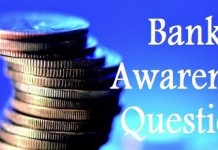Hello Aspirants. Welcome to Banking Awareness Quiz in AffairsCloud.com. Here we are creating quiz covering important questions which are common for all the bank exams and other competitive exams.
- Different ways you can operate your account are
A. Telephone or Mobile banking
B. ATM (Automated Teller Machine)
C. Branch or Over the counter service
D. All of the aboveD. All of the above
Explanation:You can operate your bank accounts in different ways like a) Internet banking b) Telephone or Mobile banking c) Branch or Over the counter service d) ATM ( Automated Teller Machine) - Different types of Loans offered by banks
A. Unsecured Personal Loan
B. Auto Loans
C. Mortgage Loans
D. All of theseD. All of these
Explanation:Currently in India we have different types of loans available ranging from personal loans to marriage loans.
1) Home Loan 2) Personal Loan 3) Car Loan or Vehicle Loan 4) Education Loan 5) Gold Loan 6) Loan against Insurance Policies 7) Loan against Bank FDs 8) Loan from PPF or EPF 9) Loan against Shares or Mutual Funds 10) Loan from unrecognized sector. - It is a particular system of banking, in which a bank places its funds in risk free assets with maturity period matching its liability’s maturity timing and maintains liquidity at the time of demand payment and their funds have no chance of becoming an NPA.
A. Universal Banking
B. Merchant Banking
C. Narrow Banking
D. Virtual BankingC. Narrow Banking
Explanation:Narrow banking is a proposed type of bank called a narrow bank also called a safe bank. Narrow banking would restrict banks to holding liquid and safe government bonds. Loans would be made by other financial intermediaries. - Which among the following is a system of payment in which the bank account holder can authorize the customer to withdraw the due amount, directly from his bank account?
A. Direct Order
B. Standing Order
C. Indirect Order
D. None of theseA. Direct Order
Explanation:In this system, the payee can withdraw any sum at any point of time. The payee is having ultimate control over the payments to decide the amount and time for payment without taking further authorization from the payer. The payer will not have any control over the withdrawals, but he can cancel them any time and need not to mention any reason for that. The Direct Debit System notifies the payee for cancellations or failures in payment, if any. Example – Gas bill, Electricity Bill, Mobile Bills etc. - CORE Banking Solution where online multiple delivery channel/(s) like _____ under one roof.
A. ATM
B. ABB
C. Debit Card
D. All of theseD. All of these
Explanation:Core Banking can be understood as centralization on banking activities. There was a time banking activities such as deposits, withdrawal, etc. were limited to base branch (the branch where the account belongs) only. But now you can do all that from anywhere you wish. Not only the same banks but different banks as well. - DTC stands for
A. Due tax clip
B. Direct turn code
C. Direct tax code
D. Debit tax companyC. Direct tax code
Explanation:The Direct Tax Code (or DTC) aimed to make the system more efficient and easy for tax payers, with simplified rules and regulations. It is a step towards replacing the four decade old Income Tax Act of India. - The buyer of goods requests his bank to give guarantee that the payment for the goods will be paid to the seller. In such case the bank issues _______.
A. Credit Card
B. Line of Credit
C. Bill of Exchange
D. Letter of CreditB. Line of Credit
Explanation:A line of credit is the most you can borrow under a revolving credit arrangement with a credit card issuer, bank, or mortgage lender. When you borrow against a line of credit, you pay interest on the amount of money you actually borrow, not on the available balance, or full amount you are able to borrow. - When the repayment of a loan starts after certain period of its disbursement, that period is
called ________.
A. Esoteric
B. Foreclosure
C. Diffusion
D. MoratoriumD. Moratorium
Explanation:It is a period of time in which there is a suspension of a specific activity until future events warrant a removal of the suspension or issues regarding the activity have been resolved. In bankruptcy law, a legally binding halt of the right to collect debt. For example, if a company is going through rough times it might have a moratorium on advertising spending. In other words, to cut costs, it won’t spend any money on advertising. - Which type of crisis occurs when the banks which have obligation to facilitate money flow may get struck their revenue assets with insolvents and become toxic assets?
A. Sub-prime Crisis
B. Super prime Crisis
C. Basic Crisis
D. None of theseA. Sub-prime Crisis
Explanation:The term “sub-prime” refers to the credit status of the borrower (being less than ideal), not the interest rate on the loan itself. “sub-prime” is any loan that does not meet “prime” guidelines. Subprime lending, also called B-paper, near-prime, or second chance lending, is the practice of making loans to borrowers who do not qualify for the best market interest rates because of their deficient credit history. - “Rupee” symbol designed by Uday Kumar and he belongs to
A. Tamil Nadu
B. Kerala
C. UP
D. DelhiA. Tamil Nadu
Explanation:The Indian rupee with a unique symbol – a blend of the Devanagri ‘Ra’ and Roman ‘R’ — joining elite currencies like the US dollar, euro, British pound and Japanese yen in having a distinct identity. The new symbol, designed by Bombay IIT post-graduate D Udaya Kumar, was approved by the cabinet reflecting the fact that the Indian currency, backed by an over-trillion dollar economy, was finally making its presence felt on the international scene.
AffairsCloud Recommends Oliveboard Mock Test
AffairsCloud Ebook - Support Us to Grow
Govt Jobs by Category
Bank Jobs Notification


